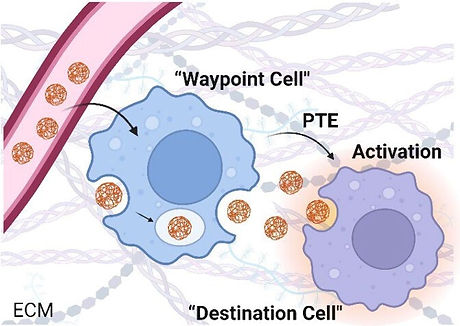Understanding Tissue:Biomaterial Interactions In Light of Their Local Microenvironment


Leveraging Particle Transfer
The cellular export of nanomedicines is emerging as a powerful mechanism for enhancing therapeutic outcomes. We study the paracrine transfer effect (PTE), a phenomenon where nanomaterials are first internalized by an initial “waypoint” cell and then exported to nearby “destination” cells, where they exert additional therapeutic effects.
Dr. Artzi has pioneered materials that respond to specific biochemical cues, enabling localized drug release and establishing a novel “depot effect” that supports this intercellular transfer. We explore how nanoparticle design can be engineered to harness PTE, with applications in cancer immunotherapy, gene regulation, and precision drug delivery. By understanding and leveraging this intercellular trafficking, we aim to develop nanomedicines that are not only targeted but also dynamic in their therapeutic reach.
Immune engineering
Cancer immunotherapy leverages immune cells and cytokines to boost the natural body defense mechanisms to fight cancer. Adequate immunotherapy should enable the recruitment, colonization, and education of effector cells to eliminate tumors. Understanding the interactions between biomaterials and the immune system along with studying the effects of administration mode, combination therapies, and therapeutic regimen on outcomes would enable the rational design of materials that can induce humoral- and cell-mediated immune responses with long lasting anti-tumor effects.


Tissue Responsive Materials
The complex microenvironment in vivo at different tissue sites with diverse cell types and under different pathological conditions may alter material properties and in turn, affect its in vivo performance. It is crucial, therefore, to carefully study tissue microenvironment and optimize materials in light of the specific conditions in which they will have to perform their function.
We believe that new advances in material design and detailed study of material-tissue interactions can open a new chapter in personalized medicine, where biomaterials are chosen and designed to precisely match the tissue and disease state, with a concomitant improvement in clinical outcomes.
Materials can no longer be considered as ‘one size fits all’ for a broadly defined indication, but should take into account the unique tissue microenvironment of each patient. This change in approach has been catalyzed by novel imaging and characterization techniques that allow us a more detailed understanding of the disease microenvironment and how it evolves over time.
Nowadays, there is a growing need to enhance the capability of theranostics procedures where nanoparticle-based sensors may provide for the simultaneous detection of several gene-associated conditions and nanodevices with the ability to monitor real-time drug action. These innovative multifunctional nanocarriers for cancer theranostics may allow the development of diagnostic systems such as colorimetric and immunoassays, and for gene therapy, drug delivery and tumor targeting systems.
Nanotechnology offers numerous tools to diagnose and treat cancer, such as new imaging agents, multifunctional devices capable of overcome biological barriers to deliver therapeutic agents directly to cells and tissues involved in cancer growth and metastasis, and devices capable of predicting molecular changes in precancerous cells.
Nanomaterials for Cancer Theranostics



